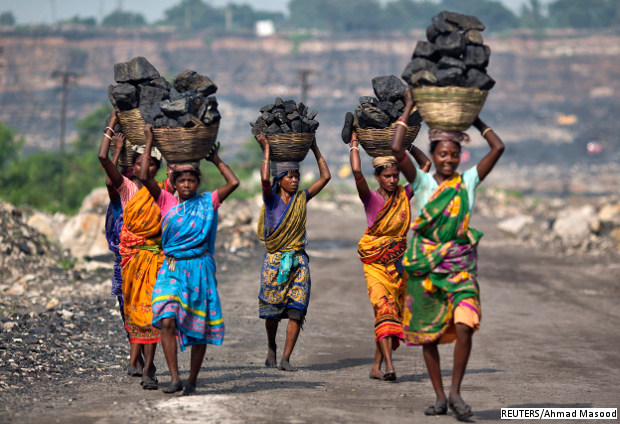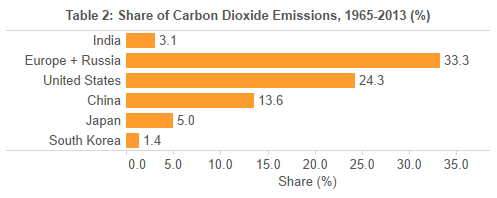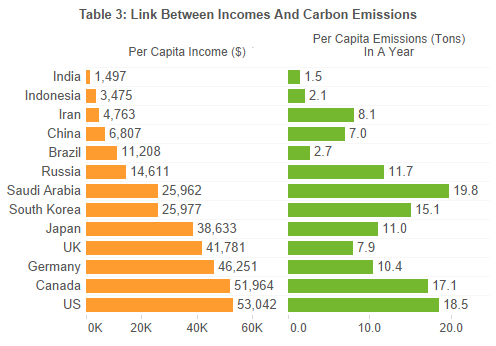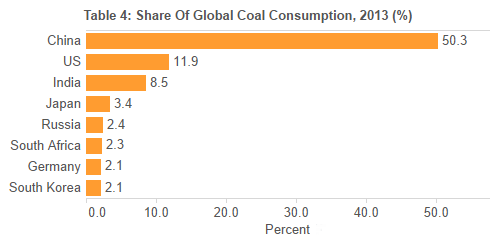Indians, Marginal Polluters. So Why Cut Coal?
Women carrying coal from a mine near Dhanbad, Jharkhand.
First of a three-part series assessing India's energy options as climate change gathers pace
Mumbai: India’s development dilemma centres around a basic calculation: the carbon emission for an average Indian is only marginally higher than the carbon dioxide produced in flying one passenger from Tokyo to San Francisco.
In other words, while a commonly-cited fact is that India, after China and the USA, is the third-largest emitter of carbon dioxide—the main gas implicated in warming the planet—globally, there is, seemingly, enough data to absolve India of special responsibility.
First, the background for this discussion:
Carbon dioxide (CO2) concentration in the atmosphere is at a record high at 404.11 parts per million (ppm), driving extreme weather events, including high temperature, storms and droughts, according to some studies. As IndiaSpend recently reported, the rainfall over rain-dependent India is becoming increasingly uncertain, unsettling the nation's agriculture, economy and politics.
Another, recent much-debated IndiaSpend story explained how India's overwhelming dependence on coal was the real reason for the government's crackdown on the global NGO Greenpeace.
Some readers said India's dependence on coal would be disastrous.
Then there's a dirty-in-every-way coalplant NTPC is building a whiff upstream of the #Sundarbans in #Bangladesh https://t.co/VC86tzWCVY
— Arati Kumar-Rao (@AratiKumarRao) May 13, 2015
Others argued that doing away with coal would be equally disastrous.
@newslaundry @IndiaSpend @ShekharGupta OK, so untill renewables become financially viable, we villagers spend night w/out electricity!
— Parikshit Jakhar (@ParikshitJakhar) May 14, 2015
What should India's path be? Coal-based or not?
To find an answer, consider three facts:
FACT 1: Citing total emissions is misleading. India’s annual carbon dioxide emission is 1.93 billion tons, compared to 1.4 billion tons emitted by Japan, the world's fifth-largest polluter. India’s emissions are spread among 1.27 billion people; Japan’s come from 127 million, a tenth of India's population. On average, a citizen of Japan is responsible for seven times as much carbon dioxide as an Indian.
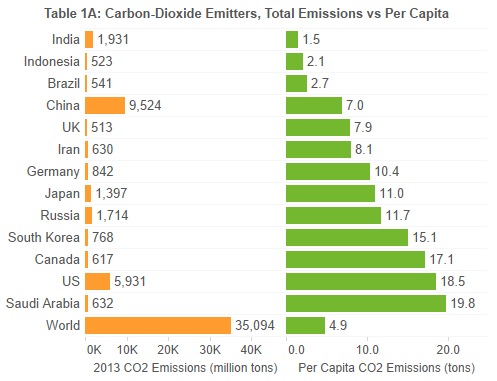 Source: BP Statistical Review of World Energy
Source: BP Statistical Review of World Energy
Citizens of countries such as UK, Germany, Canada and US have a carbon footprint between five and 12 times that of an Indian. With one-sixth of the world’s population, India accounts for a twentieth of carbon emissions.
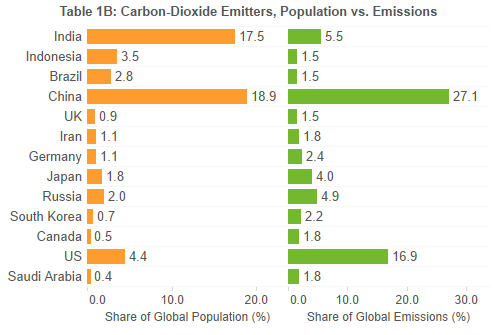 Source: BP Statistical Review of World Energy
Source: BP Statistical Review of World Energy
China and the US, with just less than one-quarter of world’s population, account for 44% of current CO2 emissions. Europe (with Russia) accounts for another 20% of emissions. India accounts for 5.5%, so, a vast majority of greenhouse gases are coming from the developed world plus China.
FACT 2: It is hard to ignore past responsibility. Per capita data are only part of the jigsaw. CO2 in the earth's atmosphere has not been emitted only over the past couple of years or decades. It has been building up for more than 100 years, since the West started industrialising. The pace picked up over the past 50 years, as incomes and consumption increased, and many developing countries also started to grow.
Between 1965 and 2013, as much as 1.1 trillion tons of CO2 was emitted (refer Table 2). Europe (including Russia) accounts for 33.3% of this total, while the US has a share of 24.3%. So, the West has been responsible for 57.6% of CO2 emitted over the past 48 years. If China and Japan are included, the combined share goes up to 76.2%, more than three-quarters of all carbon dioxide emissions over this period.
Source: BP Statistical Review of World Energy
A small set of nations—Europe, US, China and Japan—has been responsible for global warming so far, and continues to account for the bulk of greenhouse gas emissions. India’s contribution is relatively marginal and continues to remain 80% below the world average.
How right, then, are leaders from the US and Europe, when they urge India to do more to curb emissions?
FACT 3: As India develops, CO2 emissions will rise. The reasons for low per-capita emissions from India are obvious:
- As much as 25% of Indians still don’t have access to electricity.
- Automobile ownership in India is 13 vehicles per 1,000, compared to 439 in the USA, 617 in Japan and 34 in China.
- Indians fly less than nationals of other major economies—though India has the second-largest population, it is the ninth-largest aviation market. UK, which has a population 1/20th of India sees more people flying annually.
As India industrialises and incomes increase, more Indians will use electricity and drive vehicles and fly, leading to increased carbon emissions.
There is no feasible way of restricting carbon emissions—short of stopping use of all fossil fuels—coal, oil and natural gas. These three fuels account for 86.6% of the world energy consumption.
Dirty and desirable: The role of coal
Among the three major fossil fuels, coal is considered the dirtiest.
However, it is less than one-fourth the price of either oil or natural gas, and more widely available. This is why coal is more widely used in lower-income countries, such as India.
As incomes increase, countries try to move away from coal, as the development trajectories of western Europe and the USA indicate.
India is also the world's third-largest user of coal (refer Table 4).
Coal is a major bugbear for a number of environmental organisations such as Greenpeace and Sierra Club. This has lead to confrontations, such as the ban on foreign funding for Greenpeace in India.
Source: BP Statistical Review of World Energy
India accounts for just 8.5% of the world’s coal usage, while it has 17.5% of the world’s people. China is the runaway leader, accounting for just over half the coal burnt globally.
And, so, to India's limited options
As we explained, India has not been responsible for global carbon emissions in the past, and its current emissions are way below the needs of its population.
However, if India follows China's route of development by burning more coal, the consequences for the planet—and India—are likely to be devastating. This will further worsen as other developing nations with large populations, such as Bangladesh, Nigeria and Pakistan, follow this route.
The argument goes that as a responsible nation, India needs to move away from coal and increase the use of low-pollution energy sources, mainly nuclear power, hydropower, natural gas and renewable energy.
The problem with these sources is that they are costlier than coal and not as easily available. In many cases, such as renewable energy and nuclear power, the technology isn't freely available to India; much of it must be imported from the West.
If India chooses more expensive forms of energy over coal, it will contribute to global common good—at its own immediate economic cost, as we will see tomorrow. ¦
How Much Does Your Lifestyle Hurt The Environment?
Your browser doesn't support IFRAMES - please use the basic calculator instead.
Here are the second and third parts of this series.
(Amit Bhandari is a media, research and finance professional. He holds a B-Tech from IIT-BHU and an MBA from IIM-Ahmedabad.)
“Liked this story? Indiaspend.com is a non-profit, and we depend on readers like you to drive our public-interest journalism efforts. Donate Rs 500; Rs 1,000, Rs 2,000.”


